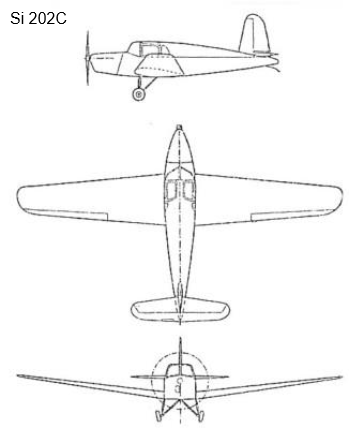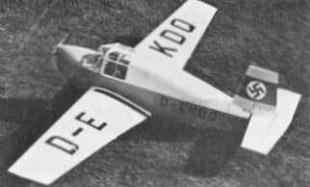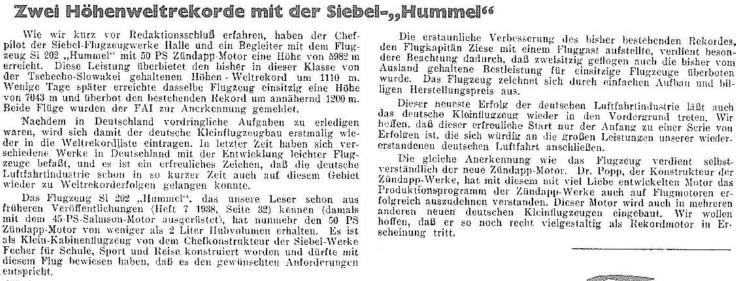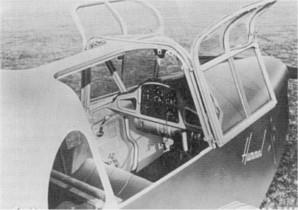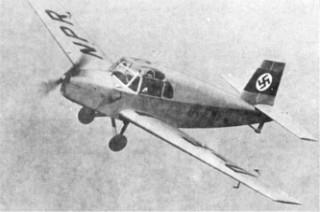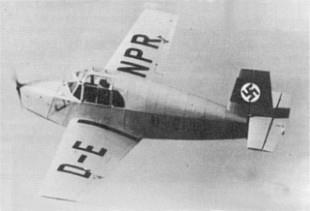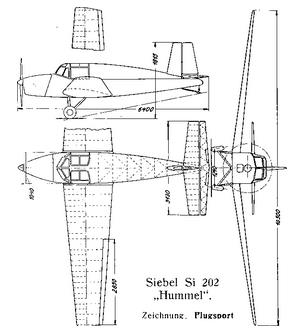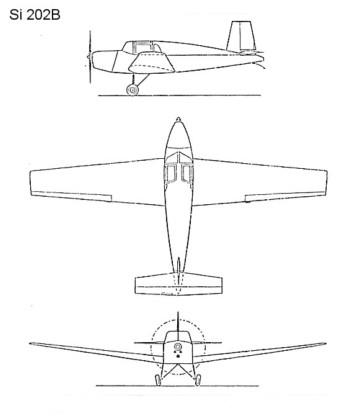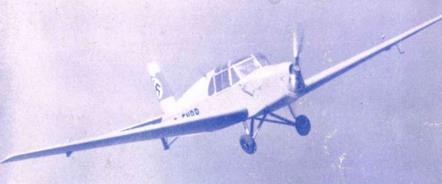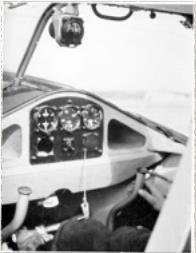Si 202C
Si 202 „Hummel".
Noch in letzter Zeit während des Pariser Salons wurde von Fachleuten in Zeitschriften die Ueberlegenheit der sogenannten ausländischen Volksflugzeuge in allen
Tonarten gerühmt. Die deutschen Ingenieure haben es nicht nötig, sich an ausländische Vorbilder zu halten, um so mehr, da der Leichtflugzeugbau gerade durch die
Segelflugentwicklung in Deutschland seinen Anfang genommen hat. Es sei nur an den viel verschrieenen Leichtflugzeug Wettbewerb 1924 in der Rhön erinnert.
Unsere Flugzeugindustrie, welche zur Zeit nicht über Beschäf-tigunglosigkeit klagen kann, hat trotzdem nebenbei noch Zeit gefunden, sich mit dieser Frage zu
beschäftigen.
Am 31. 1. 1939 erreichte Flugkapitän Ziese auf Flugzeug Si 202 „Hummel", Konstrukteur Fecher der Siebel-Flugzeug werke, Halle, mit 2-l-Zündapp-Motor-50-PS mit
Fluggast 5982 m Höhe, womit der von der Tschechoslowakei gehaltene Rekord von 4872 m überboten wurde. Am 3.2.1939 erreichte Ziese 7043 m einsitzig und
überbot den tschechoslowakischen Rekord von 5851 m.
Das Baumuster Si 202 ,JHummel" haben wir bereits im „Flugsport" 1938, S. 272 beschrieben. Durch den Einbau des 50-PS-2-l-Zündapp-Rei-henmotors an Stelle eines
Sternmotors hat die Rumpfnase eine gefällige schlanke Form erhalten. Dieses einfache Maschinchen erfüllt alle Ansprüche, die man an ein Flugzeug dieser
Größenordnungen für Anfangsschulung: auf Motorflugzeugen sowie für den Uebungs-, Reise-und Sportflug stellen darf.
Der einholmige Flügel in Holzbauweise besitzt eine größte Flügeltiefe von 1700 mm.
Doppelsteuerung (vgl. den nebenstehenden Längsschnitt). Einfache und robuste Ausführung. Zweite Steuerung leicht ein- und ausbaubar. Seitensteuer mit parallel
geführten Pedalen. Bremstätigkeit für linkes und rechtes Rad. Ein zentraler Knüppel mit zwei Handgriffen ermöglicht einfaches Ein- und Aussteigen und bequemes
Sitzen. Trimmung durch Handhebel an Kabinendecke.
Kraftstoffbehälter hinter dem brandsicheren Rumpfspant aufgehängt. Oelb ehält er mit Rücksicht auf einfache Pflege der Maschine im Motorraum untergebracht.
Ausrüstung: Höhenmesser, Fahrtmesser, Kompaß, Uhr, Drehzähler, Brennstoffuhr, Oeldruckmesser, Zündschalter in leicht zugänglicher Weise im Gerätebrett
angeordnet. Ablegetaschen für Karten,
Handschuhe u. dgl. im Gerätebrett, Feuerlöscher, Sanitätspack, Sitzkissen, Werkzeug usw.
Spannweite 10,5 m, Länge 6,4 m, Höhe 1,85 m, mittlere Flügeltiefe 1,4 m, Tragflächeninhalt 14 m2, Flächeninhalt Höhenleitwerk 2,25 m2, Seitenleitwerk 0,9 m2,
Querruder 2X0,48 m2, Tragflächenbelastung 38,6 kg/m2, Leistungsbelastung 10,8 kg/PS.
Rüstgewicht 310 kg, Zuladung 230 kg, Fluggewicht 540 kg.
HÖchstgeschw. 160 km/h, Reise 140 km/h, Lande 70 km/h, Kraftstoffverbrauch 9,5 1/100 km, Flugweite (45 1 Vorrat) 470 km, Steigzeit auf 1000 m 8,5 Min.,
Dienstgipfelhöhe 3300 m, absolute Gipfelhöhe 4300 m.
The Si 202 „Hummel“ (bumblebee) was a side-by-side two-seat light cabin monoplane designed by Friedrich Fecher of the Siebel Flugzeugwerke KG of Halle. The nickname „Hummel“ came from the stubby silhouette of the plane and its resemblance to the insect. First appearing in 1938, the Si 202 Hummel was designed to bean economical single-engine sporting aircraft for two persons with the emphasis on ease of handling.
The Si 202 was entirely of wooden construction with a single-spar plywood-and fabric-covered wing, a plywood-covered fuselage, plywood-covered ailerons, fin and tail-plane, and fabric-covered rudder and elevator. The cabin seated two persons side-by-side with central control column and dual rudder pedals. The fuel tank in the fuselage behind the fireproof bulkhead was of 45 l capacity. The cockpit was equipped with only the most important flight and engine instruments, which were more than adequate for visual flight.
The first prototype, the Si 202 V1 (D-ESFH) made its maiden flight on 26 April 1938 with pilot Wolfgang Ziese. The flight test program was continued in May 1938 with a 45 hp Samson AD 9b nine-cylinder radial air-cooled engine, this and the Si 202 V4 (D-EHCB) which was similarly powered serving as prototypes for the Si 202A production model. The Si 202 V3 (D-EKDQ) was powered by a 62 hp Walter Mikron II four-cylinder inline air-cooled engine, but the principal version was the Si 202B with a 50 hp Zündapp 9-092 four-cylinder inline air-cooled engine, prototypes of this. model including the Vl1 (D-EEJD), V12 (D-ERHN) and V13 (DEFLC). A further version was the Si 202C with a 60 hp Hirth HM 515 engine. The engine power was sufficient to provide the aircraft, which weighted just 290 kilograms empty, with an excellent performance and good fuel consumption.
Twenty-five Si 202s were delivered during the course of 1939 and a further 41 had been manufactured when production terminated in March 1941. At the time, one could buy a „Hummel“ for merely 6000 Reichsmark. Most of the planes remained in Germany, although a few were exported, for example to Hungary or Slovakia.
At the beginning of 1939 the Si 202 set two world altitude records: on 31 January pilot Wolfgang Zeise reached with „Hummel“ 5,982 meters with two persons and only a few days later he reached 7,043 meters with one person – both new world records in its class . Later in the summer of 1939 pilot Christoph Hilliger even maneuvered the „Hummel“ to an impressive new world record of 7,500 m (single person).
The small aircraft also won first place in its class in numerous air races, rallies and endurance flights.
| Type |
A |
B |
C |
V3 |
| Engine |
1 Salmson AD-9 |
1 Zündapp Z 9-092 with a fixed prop. Ø 1.90 m. Fuel 45 l, oil 5 l |
1 Hirth HM 515 with a fixed prop. Ø 1.80 m. Fuel 80 l,oil 5 l |
1 Walter Mikron II |
| Dimensions |
Length 6.40 m, height 1.85 m, span 10.5 m, wingarea 14.00 m2, , max. loadfactor (P3) 5.70 g, (S4) 7.20 g |
Length 6.50 m, height 1.85 m, span 10.6 m,wingarea 14.00 m2, wingloading 39.25 kg/m2, max. loadfactor (P3) 5.70 g, (S4) 7.20 g |
|
| Weights |
Empty 300 kg, loaded 520 kg , max. take off weight |
Empty 320 kg, flying weight 550 kg |
Empty 355 kg, flying weight 620 kg |
|
| Performance |
Max. speed 155 km/h, cruising speed 140 km/h, 8.5 min to 1000 m |
Max. speed 160 km/h, cruising speed 140 km/h, landing speed 72 km/h, required startfield 250 m, landingfield 170 m, service ceiling 2300 m, range 500 km, climb 120 m/min., 10 min to 1000 m
|
Max. speed 180 km/h, cruising speed 150 km/h, climb 126 m/min, 9 min. to 1000 m, range 800 km |
|

